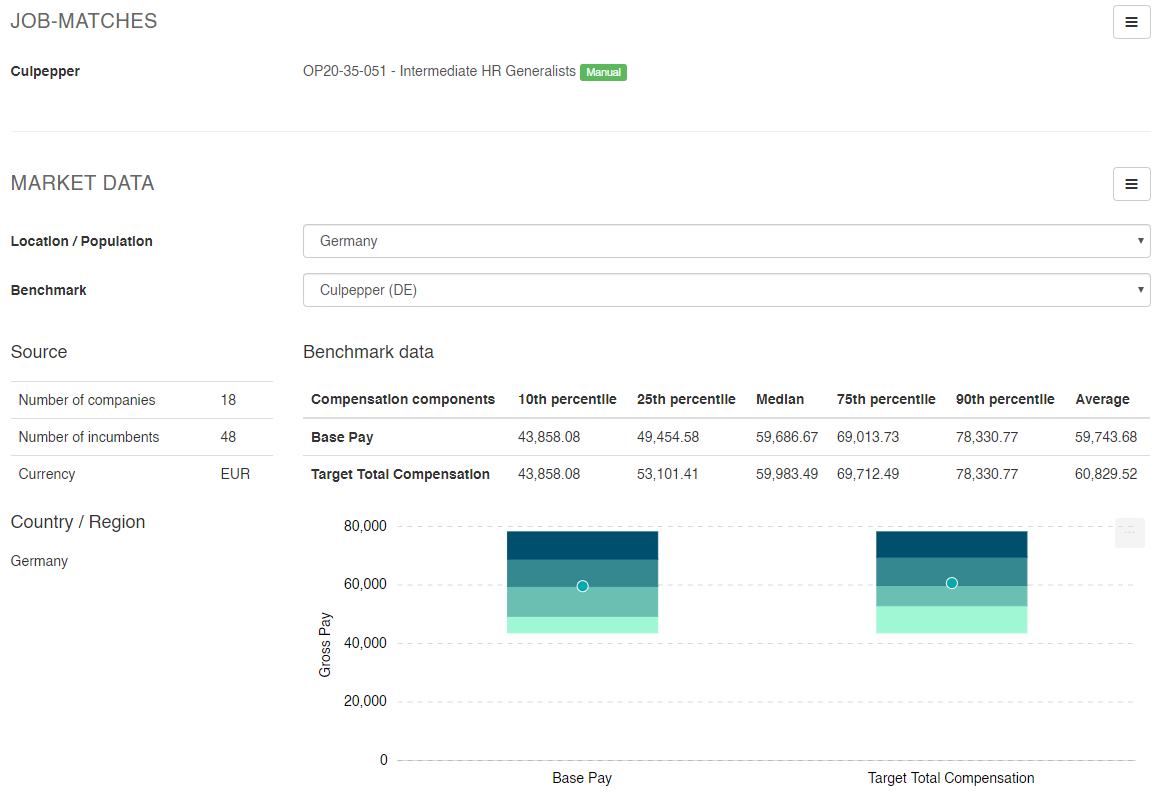Job matching methodology
Global vendors often use the same job matching methodology
and data collection process, making their surveys an
attractive choice for firms operating worldwide. Local
vendors may use benchmarking approaches tailored to national
or regional needs and usually attract more domestic
participants.
It therefore makes sense to assess the size of the
respective database, its participants and the availability
of job specific benchmark data for every country that you
are interested in. There is no one-size-fits-all approach.
Collective bargaining agreements are an alternative source
for salary comparisons since pay in some markets -
especially Europe - is heavily regulated through labour
agreements that cover a large employee population.
In a market like Germany, the strongest salary survey
databases contain about 500,000 individual data points
whereas the labour agreements for the metal and electronic
industry alone cover more than 3,500,000 employees. In some
cases, this data might be the better fit, at least for
non-exempt jobs, and is often accessible at no cost.
gradar aligns strongly with collective bargaining agreements
and we’ve captured the correlations in our own compensation
survey rosetta stone documentation.
The reliability of the job matching process
Job matching is about identifying benchmark jobs from
compensation surveys in order to assess the market price of
a position. The validity and reliability of a market
benchmark depends on the quality of the job matching between
internal and external jobs.
There are four common types of job matching methodologies
used today, though some elements may be combined into a
unified approach:
-
Matching by job title. This approach is
most common for vendors that collect data directly from
individuals and not from HR and Compensation
professionals. As a result, it’s the most unreliable
approach and is only feasible with a minimum level of
accuracy for very generic jobs or professions such as
plumbers or accountants. Some vendors even add personal
characteristics such as job tenure or age to the analysis.
-
Matching by benchmark job. Vendors use
this approach by adding the core duties and
responsibilities to a benchmark job profile, though it is
fairly uncommon. Different ranks need separate
descriptions, which makes this a fairly accurate approach.
However, it’s difficult to select a better-fitting match
if a higher or lower description does not exist.
-
Capsule job descriptions. This is the
enhanced version of matching by benchmark job, where a
survey vendor would describe the main responsibilities and
core duties in much more detail and outline modifiers for
lower or higher levels of requirements. This approach is
most common in club surveys.
-
Job families with a non-analytical job leveling
methodology.
Most vendors today use this approach, with the quality of
the generic job family descriptions satisfactory in most
surveys. However, the more sub-families available, the
more scattered the job matching and the less reliable the
results. The quality of the generic job level descriptions
varies a lot between and within surveys. The
non-analytical approach is not as accurate as analytical
job evaluation results and should not be used for pay
equity decisions or as basis for compensation structuring.
Culpepper, our strategic partner, uses a combination of job
classifications and levels (Executive, Management,
Professional Individual Contributors and Support Individual
Contributors) with comprehensive job family descriptions for
Executives, Engineering, Health Care, Life Sciences,
Operations, Sales and Technology roles.
Accurate job matching is the foundation of salary benchmarks
and market comparisons. And matching an internal job to an
external benchmark job of similar content is the key to
accessing benchmark data from salary surveys. The benchmark
data can be used to compare employees' salaries against
market rates and may be included in the modelling of pay
bands and in the determination of a competitive ratio of
base and variable pay.
-
gradar automatically suggests benchmark jobs that are
likely to be a good fit to the position that you have
evaluated.
-
gradar is compatible with benchmark jobs from a number of
locally and globally recognised publishers where the
appropriate surveys for your organisation cover relevant
industries, jobs and markets.
-
gradar enables you to store the job grading and job
matching decision online.
Data in compensation surveys
Compensation survey market data is not a representative
source of information. There can be no guarantee that
conclusions drawn from a certain sample will extend to the
population as a whole. Salary reports should always be used
with care!
The population of a survey is made up from either the
participating companies’ incumbent data, submitted by HR, or
direct submissions from employees. It’s constantly changing,
so vendors are faced with the challenge to maintain a
certain level of consistency in their benchmark salaries
over a period of time. To do this, the providers use
different approaches to analyse and prepare their salary
reports.
Market values from descriptive statistics
This approach represents salary information through
percentiles:
-
Based on pure data input
Data is collected and described as is. There is no editing
of the population or removal of data points. Vendors that
follow this approach face volatile results in an annual
comparison since the population rarely remains stable.
This becomes more of a problem as the population size
decreases.
-
Based on edited data input
Automated computer programmes - or human analysts - edit
the data by removing ‘outliers’ in order to keep median
values relatively stable. A deviation of median values by
+/- 5% may be shown over a given period of time.
The latter approach is likely to work well with submissions
from HR or Compensation professionals as the vendor’s
analyst will have someone to discuss the data with. The
vendors who use direct inputs from employees will be fishing
in the dark and may have to rely on the statistical analysis
alone, without being able to validate the data input.
gradar and Culpepper collect compensation data directly from
HR professionals in participating organizations. We combine
the power of data analytics with the experience of their
Compensation Specialists to ensure that data is both
accurate and reliable.
Market values from statistical models
Statistical data is calculated through regression analysis
and significance testing to show a possible market salary.
This approach is only used in a few surveys.
Market values from experience
Data and experience from candidate interviews are combined
to show market salary ranges. This approach is often used by
local and global recruiting agencies.










